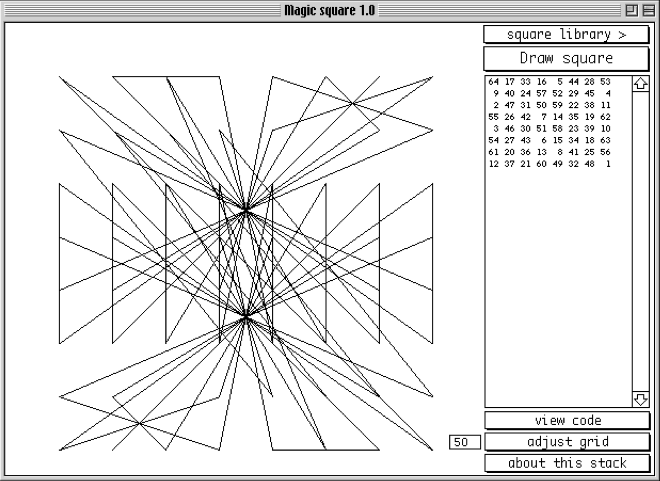3D magic cube viewer
3D renderings of magic cubes were the departure point for my digital artwork CubeLife, where the magic cube images mutate through interaction with a heartbeat monitor. You can view stills from an early adaptation of this applet or go straight to a movie of the very first images in sequence (we had no order 5 cube at that stage so we mocked one up using a squentially-numbered 3D grid). The Java for the artwork (no longer supported in browsers) was written by Greg Turner, from my initial rough pseudocode. Images from the development phases show pleasing rendering accidents and several cubes in various colours, one of them (in blue) malformed because part of the integer sequence was missing. There’s also a short colour movie of early tests. This was all in 1998-99, so I’m archiving connected material and preparing background research on the cultural interpretation of number at the dedicated site for the cubeLife project.
UPDATE: Greg Turner recently rewrote the magic-cube generating part of cubeLife using processing.js, which will be made available soon.
The most recent work
In collaboration with Fania Raczinski:
- development of a web-based magic square visualiser
- a presentation on magic square research for the Computer Arts Society (CAS)
- Video of our CAS 2020 presentation
- a more detailed presentation for the Symmetry 2021 festival on magic square pattern homologies
The HyperCard foundations of cubeLife

I originally wrote the code to draw magic squares using Apple’s venerable original app-kit HyperCard. I used it for collecting and cataloguing the magic squares I found on the web and elsewhere. This was after years of experimenting with magic square permutations in squared paper notebooks. The interest stayed with me and led to the various later works based on magic matrices (squares and cubes). The research covers both aesthetic and mathematical (combinatorial) explorations, the latest of which can be found in our Symmetry 2021 presentation.
To run the original work (from around 1995) on a legacy Apple Mac (System 6.8 - 9 or Classic on OS X or in emulation) you can download my first magic square application (zip) or .sit file) - you'll need HyperCard Player (still available), if it's not already on your old Mac. It draws the magic line patterns formed by magic squares and provided a way of storing and examining magic lines. If you want more information on the subject or have a particular inquiry, the links on Harvey Heinz's excellent pages on number patterns is a good place to start.
Archival information only: Java applets are no longer supported
Please note: although there is a refined version of this Java applet (developed in collaboration with Greg Turner) Java Applets are no longer supported in modern browsers. This applet enabled views of magic cubes from order 3 to order 12 in one window, an ability to change the cube's foreground and background colours, turn numbers on and off, and move it in 3D space.
The thumbnails above link to 3D visualisations of magic cubes, using a Java applet designed and written in 1998 by the late Ben Daglish, a friend of mine (programmer and musician).
- the 'n' key shows/hides numbers (orders 3 and 5 are on by default). Click once in in the applet window and wait a few seconds.
- to rotate click and drag in the applet window.
- the red animation on the order 3 and 4 cubes traces the magic line created by joining all points in sequence from first to last. Orders 3 and 4 have an elementary perspective effect to enhance depth, but orders 5 to 9 are shown in 1-pixel line view because otherwise the pattern becomes obscured. If you press 's' a starfield is turned on or off (I'm not conviced, but Ben insisted on creating a Borg Cube effect...






